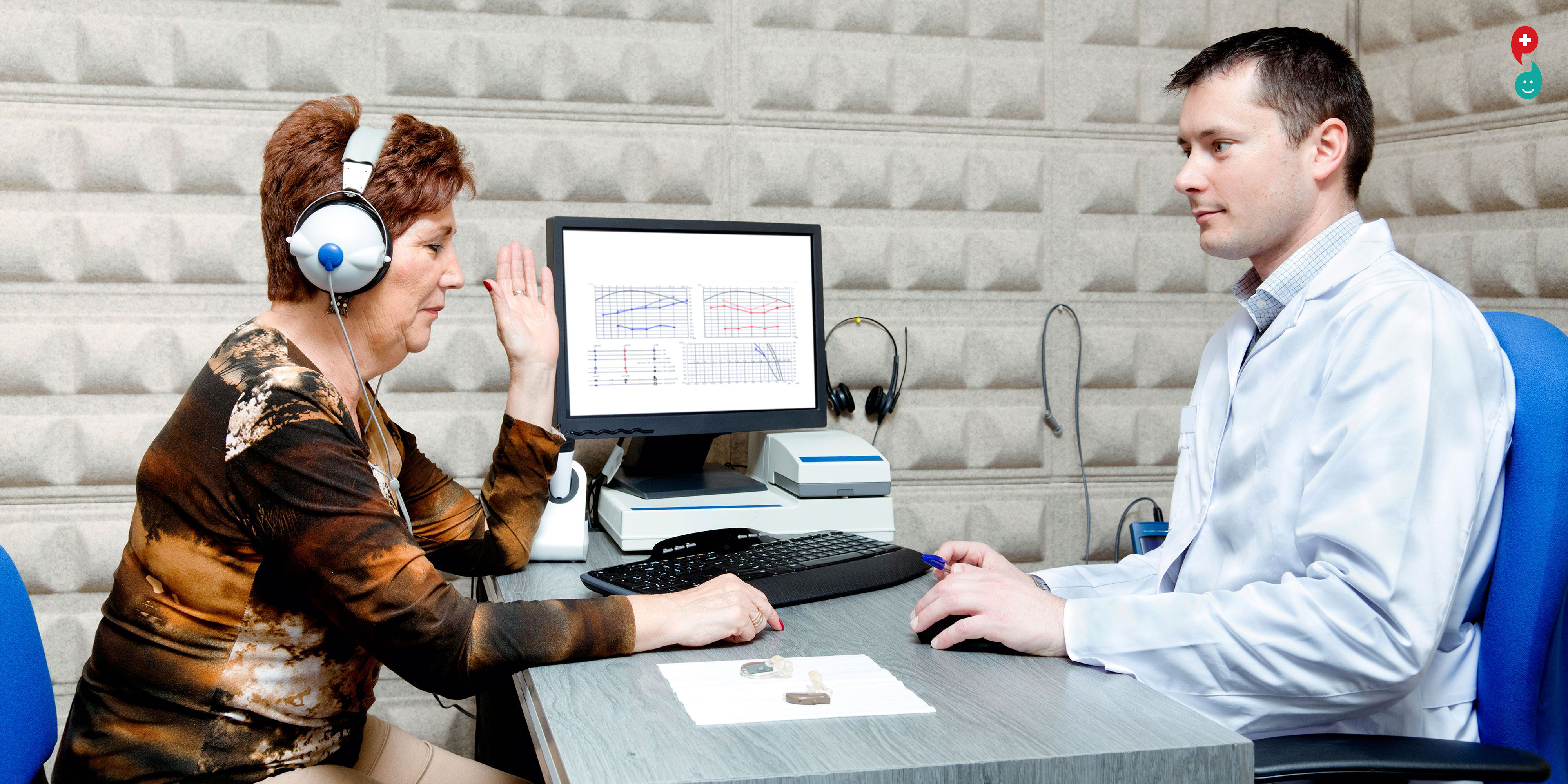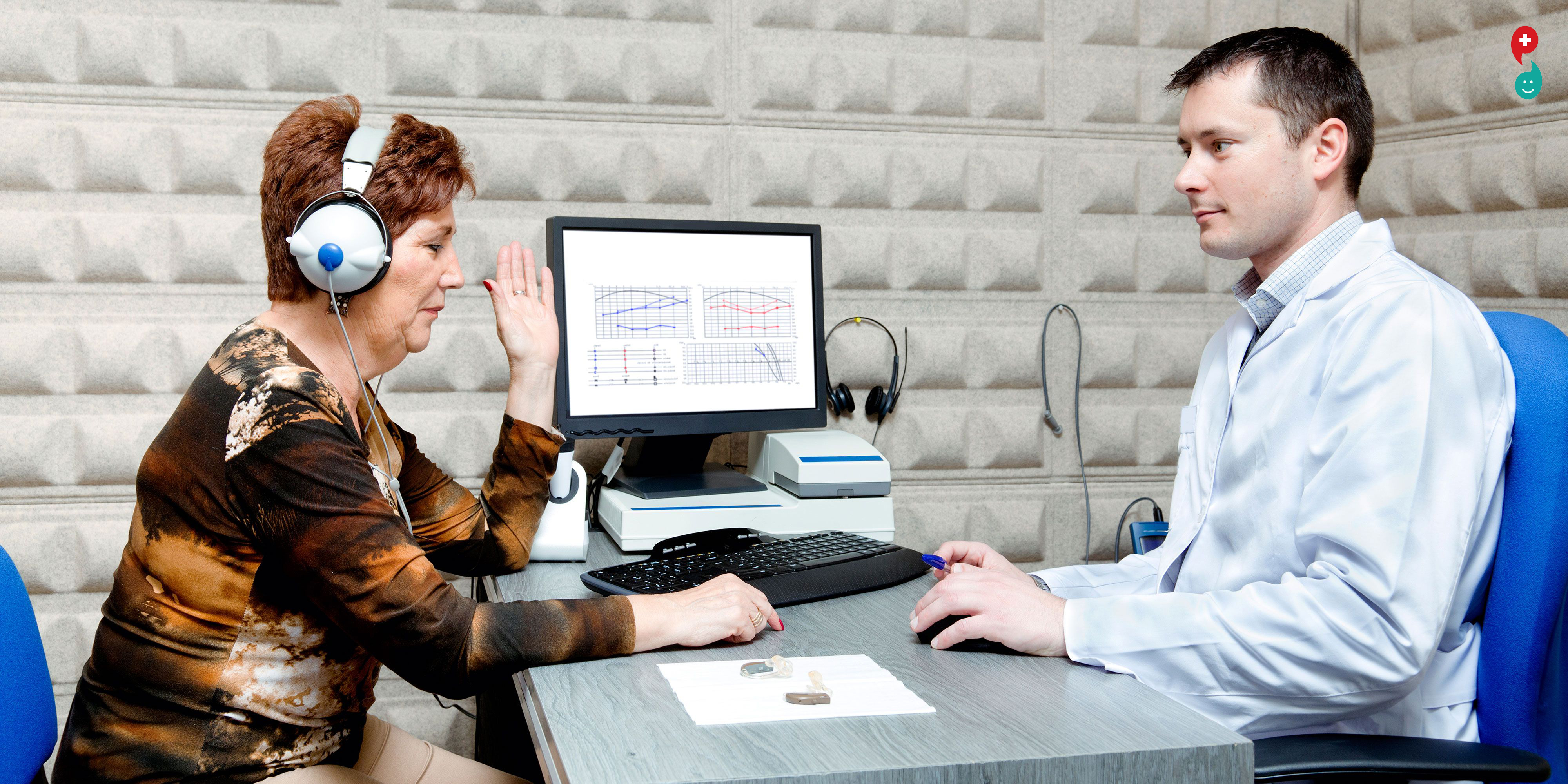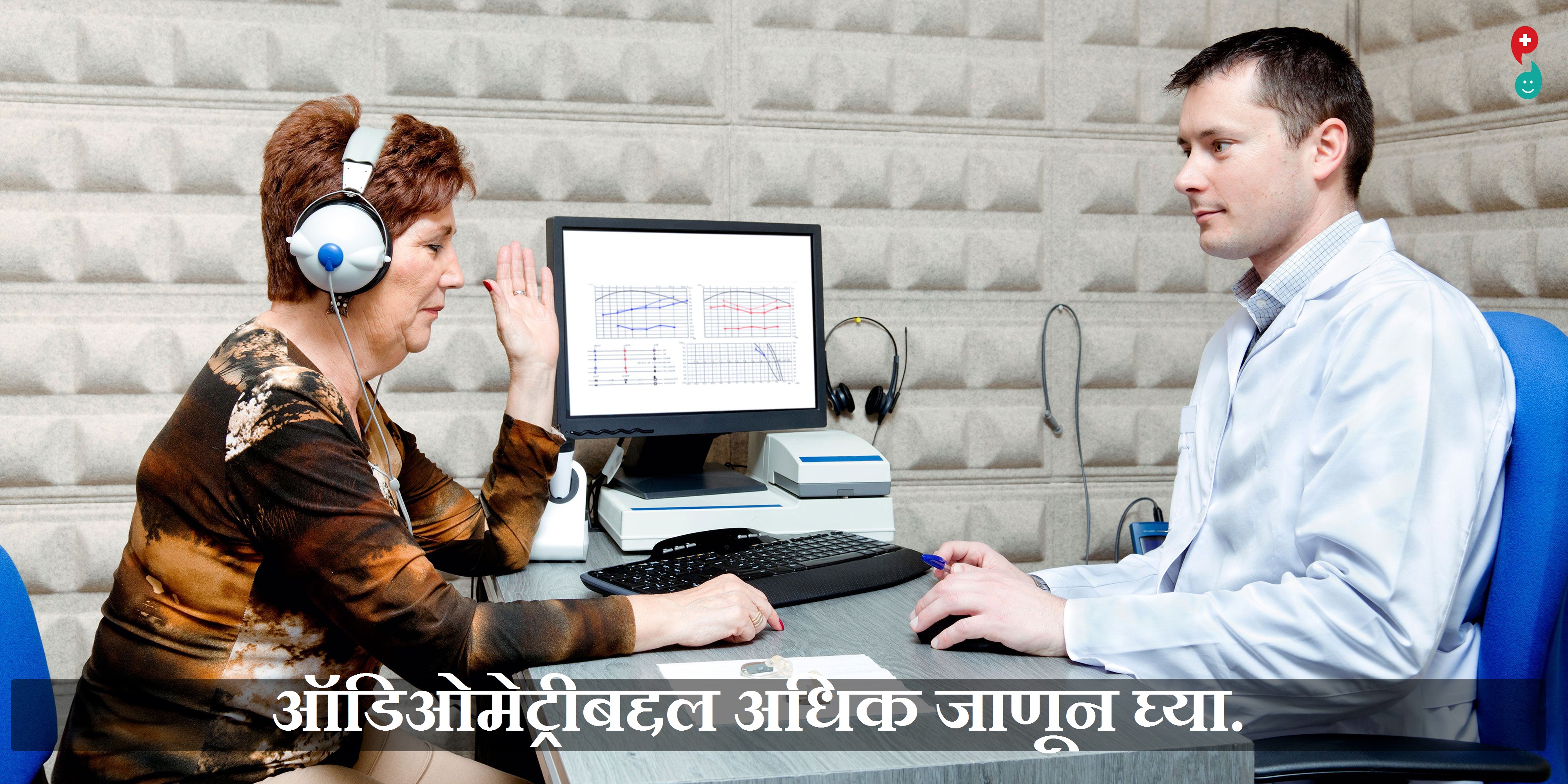You may have had your hearing tested in school or at the doctors office. You might remember putting earphones on and raising your hand whenever you heard the "beep." This is pure-tone testing. It is also called air conduction testing since the sounds go through your outer and middle ear. This test helps find the quietest sound you can hear at different pitches, or frequencies. Having earphones on lets the sounds go to one ear at a time.
Sometimes, it is not possible to use earphones. An example is when a child refuses to wear them. In these cases, sounds come through speakers inside a sound booth. This is sound-field screening. The sounds go into both ears at the same time. This type of testing does not show if there is a hearing loss in only one ear.
You may respond to the sounds by
Raising a finger or hand
Pressing a button and pointing to the ear where you heard the sound
Saying "yes" to indicate that you heard the sound
The audiologist records your results in an audiogram.
Testing Young Children
Young children sometimes do better if they play games. There are ways to test your child's hearing through play. The most common ways are visual reinforcement audiometry (VRA) and conditioned play audiometry (CPA).
Visual Reinforcement Audiometry
This is the best way to screen children between 6 months and 2 years old. The audiologist will teach your child to look to where the sound came from. When your child looks in the direction of the sound, he sees a moving toy or flashing light. This rewards your child for looking at the sound. Both ears are tested at the same time.
Conditioned Play Audiometry
This type of testing is good for toddlers and preschoolers, ages 25. Your child will do something each time she hears a sound. She might put a block in a box, put pegs in a hole, or put a ring on a cone.
Bone Conduction Testing
Audiologists use this type of testing when something, such as wax or fluid, is blocking your outer or middle ear.
For this test, the audiologist will put a small device behind your ear or on your forehead. The sounds sent through this device cause your skull to gently vibrate. This vibration goes to the inner ear, or cochlea, and skips the outer and middle ear. This test tells the audiologist how well you hear and if there is a problem in the outer or middle ear.
An audiometry exam tests your ability to hear sounds. Sounds vary, based on their loudness (intensity) and the speed of sound wave vibrations (tone). Hearing occurs when sound waves stimulate the nerves of the inner ear. The sound then travels along nerve pathways to the brain. Sound waves can travel to the inner ear through the ear canal, eardrum, and bones of the middle ear (air conduction). They can also pass through the bones around and behind the ear (bone conduction). The INTENSITY of sound is measured in decibels (dB). A whisper is about 20 dB. Loud music (some concerts) is around 80 to 120 dB. A jet engine is about 140 to 180 dB. Sound greater than 85 dB can cause hearing loss after few hours. Louder sounds can cause immediate pain, and hearing loss can develop in a very short time. The TONE of sound is measured in cycles per second (cps) or Hertz: Low bass tones range around 50 to 60 Hz. Shrill, high-pitched tones range around 10,000 Hz or higher. The normal range of human hearing is about 20 to 20,000 Hz. Some animals can hear up to 50,000 Hz. Human speech is usually 500 to 3,000 Hz.
How the Test is performed?
Your health care provider may test your hearing with simple tests that can be done in the office. This may include completing a questionnaire and listening to whispered voices, tuning forks, or tones from an ear examination scope.
A specialized tuning fork test can help determine the type of hearing loss. The tuning fork is tapped and held in the air on each side of the head to test the ability to hear by air conduction. It is tapped and placed against the bone behind each ear (mastoid bone) to test bone conduction. A formal hearing testing can give a more exact measure of hearing. Several tests may be done:
Pure tone testing (audio gram): For this test, you wear earphones attached to the audiometer. Pure tones are delivered to one ear at a time. You are asked to signal when you hear a sound. The minimum volume required to hear each tone is graphed. A device called a bone oscillator is placed against the mastoid bone to test bone conduction.
Speech audiometry: This tests your ability to detect and repeat spoken words at different volumes heard through a head set.
Emittance audiometry: This test measures the function of the ear drum and the flow of sound through the middle ear. A probe is inserted into the ear and air is pumped through it to change the pressure within the ear as tones are produced. A microphone monitors how well sound is conducted within the ear under different pressures.
How to Prepare for the Test
No special steps are needed.
Will test cause any discomfort?
There is no discomfort. The length of time varies. An initial screening may take about 5 to 10 minutes. Detailed audiometry may take about 1 hour.
Why is this Test performed?
This test can detect hearing loss at an early stage. It may also be used when you have hearing problems from any cause.
How are test results interpreted?
Normal results include: The ability to hear a whisper, normal speech, and a ticking watch is normal. The ability to hear a tuning fork through air and bone is normal.
In detailed audiometry, hearing is normal if you can hear tones from 250 to 8,000 Hz at 25 dB or lower.
What does abnormal result mean?
There are many kinds and degrees of hearing loss. In some types, you only lose the ability to hear high or low tones, or you lose only air or bone conduction. The inability to hear pure tones below 25 dB indicates some hearing loss. The amount and type of hearing loss may give clues to the cause, and chances of recovering your hearing. The following conditions may affect test results:
Acoustic neuroma
Acoustic trauma from a very loud or intense blast sound
Age-related hearing loss
Alport syndrome
Chronic ear infections
Labyrinthitis
Meniere disease
Ongoing exposure to loud noise, such as at work or from music
Abnormal bone growth in the middle ear, called otosclerosis
Ruptured or perforated eardrum
Are there any risks in this test?
There is no known risk.
शुद्ध स्वर ऑडियोमेट्री :
आपण शाळेत किंवा डॉक्टरांच्या कार्यालयात आपली चाचणी ऐकली असेल. जेव्हा आपण "बीप" ऐकले तेव्हा आपल्याला इयरफॉन ठेवणे आणि आपला हात फिरविणे लक्षात ठेवणे कदाचित लक्षात असू शकते. हे शुद्ध-टोन चाचणी आहे. आपल्या बाहेरील आणि मध्यम कानाने आवाज ऐकल्यानंतर हे एअर कंडक्शन चाचणी देखील म्हणतात. ही चाचणी वेगवेगळ्या खेळपट्ट्या किंवा फ्रिक्वेन्सीजवर आपण ऐकू शकतील अशा शांततेचा आवाज शोधण्यात मदत करते. इयरफोन्स येत असताना आवाज एका वेळी एक कानात जाऊ देते.
कधीकधी इयरफोन वापरणे शक्य नाही. एक उदाहरण म्हणजे जेव्हा एखादी मुल त्यांना घालण्यास नकार देते. या बाबतीत, ध्वनी एक आवाज बूथच्या आत स्पीकर्सद्वारे येतात. हे ध्वनी-फील्ड स्क्रीनिंग आहे. ध्वनी एकाच वेळी दोन्ही कानांत जातात. या प्रकारचे चाचणी दर्शवित नाही की फक्त एक कान मध्ये ऐकणे कमी आहे.
आपण ध्वनींना प्रतिसाद देऊ शकता.
एक बोट किंवा हात वर करणे.
एक बटण दाबून आणि त्या कानात इशारा केला जेथे आपण आवाज ऐकला.
आपण आवाज ऐकले असल्याचे दर्शविण्यासाठी "होय" असे म्हणत आहे.
ऑडिओलॉजिस्ट आपले परिणाम ऑडिओग्राममध्ये रेकॉर्ड करते.
मुलांचे परीक्षण :
लहान मुले कधी खेळ खेळतात तर काही चांगले करतात. नाटकाने आपल्या मुलाची ऐकण्याची चाचणी घेण्याचे मार्ग आहेत. व्हिज्युअल मजबुतीकरण ऑडिओमेट्री (व्हीआरए) आणि कंडिशन प्ले ऑडिओमेट्री (सीपीए) सर्वात सामान्य मार्ग आहेत.
व्हिज्युअल मजबुतीकरण ऑडिओमेट्री :
6 महिने ते 2 वर्षांच्या दरम्यान मुलांना स्क्रीन करण्याचा हा सर्वोत्तम मार्ग आहे. ऑडिओलॉजिस्ट आपल्या मुलाला आवाज कसा येईल हे पहायला शिकवेल. जेव्हा आपले मुल आवाजच्या दिशेने पाहतो तेव्हा त्याला हलणारी खेळणी किंवा चमकणारा प्रकाश दिसतो. हे आपल्या मुलाला आवाज पाहण्याकरिता बक्षीस देते. दोन्ही कान एकाच वेळी चाचणी केली जातात.
कंडिशन प्ले ऑडिओमेट्री :
या प्रकारचे चाचणी मुलांसाठी आणि 2-5 वयोगटातील प्रीस्कूलरसाठी चांगले आहे. प्रत्येक वेळी जेव्हा ती आवाज ऐकते तेव्हा आपले मूल काहीतरी करेल. ती एखाद्या बॉक्समध्ये ब्लॉक ठेवू शकते, खड्ड्यात डोके ठेवू शकते किंवा शंकूवर अंगठी घालू शकते.
हाड कंडक्शन चाचणी :
ऑडिओलॉजिस्ट या प्रकारच्या चाचणीचा वापर करतात जेव्हा मेण किंवा द्रव म्हणून काहीतरी आपल्या बाह्य किंवा मध्य कान अवरोधित करीत आहे.
या चाचणीसाठी, ऑडिओलॉजिस्ट आपल्या कानाच्या मागे किंवा आपल्या कपाळावर एक छोटेसे डिव्हाइस ठेवेल. या डिव्हाइसद्वारे पाठविलेले आवाज आपले खोके हळूवारपणे कंपित करतात. हे कंपन आंतरिक कानात किंवा कोक्लेआकडे जाते आणि बाहेरील आणि मध्य कान वगळते. हे चाचणी ऑडिओलॉजिस्टला आपण किती चांगले ऐकता आणि बाहेरील किंवा मध्यवर्ती कानात समस्या असल्यास सांगते.
ऑडिओमेट्री चाचणी ध्वनी ऐकण्याची तुमची क्षमता तपासते. ध्वनी त्यांच्या तीव्रतेनुसार (तीव्रता) आणि ध्वनी वेव्ह कंपनेन्स (टोन)त्याच्या गतीनुसार भिन्न असतात.
आपणास ऐकणे तेव्हा शक्य होते जेव्हा ध्वनी लाटा कानाच्या आतल्या नसबळांना उत्तेजित करतात. नंतर आवाज मेंदूच्या नक्षीमार्गाकडे जातो.
साउंड लाईव्ह कानच्या नहर,आडवा आणि मध्य कान (वायु प्रवाह) च्या हाडांद्वारे अंतर्गत कानात प्रवास करू शकतात. ते कान आणि हाडांच्या मागे (हाडांच्या चालना)देखील पार करू शकतात.
ध्वनीची तीव्रता डेसिबल (डीबी)मध्ये मोजली जाते:
कुजबुजण्याचा ध्वनी हा सुमारे 20 डीबी आहे.
जोरदार संगीतचा ध्वनी हा (मैफिल)सुमारे 80 ते 120 डीबी आहे.
जेट इंजिनचा ध्वनी हा 140 ते 180 डीबी आहे.
85 डीबीपेक्षा जास्त आवाज ऐकण्यामुळे काही तासांनी ध्वनी ऐकण्याची क्षमता नष्ट होऊ शकते.
ध्वनी प्रति सेकंद (सीपीएस) किंवा हर्टझमध्ये मोजली जाते:
लो बॅस टोन सुमारे 50 ते 60 हर्ट्ज असतात.
श्रिल, हाय-टच टोन सुमारे 10,000 हर्ट्ज किंवा त्याहून अधिक.
सामान्य श्रवण सामान्य श्रेणी 20 ते 20,000 हर्ट्ज असते. काही प्राणी 50,000 हर्ट्जपर्यंत ऐकू शकतात. मानवी भाषण सहसा 500 ते 3,000 हर्ट्ज असते.
चाचणी कशी केली जाते?
आपले डॉक्टर आपली चाचणी सोप्या चाचण्यांसह करू शकतात जे दवाखान्यात केले जाऊ शकतात. यात प्रश्नावली पूर्ण करणे आणि कानाच्या चाचणी मधील आवाज, ट्यूनिंग फोरक्स किंवा टोन ऐकणे समाविष्ट असू शकते.
विशिष्ट ट्यूनिंग फोर्क चाचणी ही ध्वनी ऐकण्याच्या नुकसानाचे प्रकार ठरविण्यात मदत करू शकते. वायु वाहनाद्वारे ऐकण्याची क्षमता तपासण्यासाठी ट्यूनिंग कांटा वापरला जातो. हाडांच्या वाहनाची तपासणी करण्यासाठी प्रत्येक कान हाडाच्या(मास्टॉइड हाड)मागे टॅप केले जाते.
औपचारिक चाचणी ही ध्वनी ऐकण्याच्या तपासणी मध्ये अधिक अचूक माप देऊ शकते. अनेक चाचण्या केल्या जाऊ शकतात:
शुद्ध टोन चाचणी (ऑडिओग्राम) - या चाचणीसाठी, आपण ऑडिओमीटरशी संलग्न इयरफोन घालता. एका वेळी एका कानाने शुद्ध टोन वितरित केले जातात. आपण आवाज ऐकता तेव्हा आपल्याला सिग्नल करण्यास सांगितले जाते. प्रत्येक टोन ऐकण्यासाठी आवश्यक असलेले किमान वॉल्यूम आहे. हाडे ऑक्सिलेटर नावाच्या यंत्रास हाडांच्या वाहनाची तपासणी करण्यासाठी मास्टॉइड हाड विरूद्ध ठेवला जातो.
स्पीच ऑडिओमेट्री - हे डोके सेटद्वारे ऐकल्या जाणार्या वेगवेगळ्या व्हॉल्यूमवर बोललेल्या शब्दांचा शोध आणि पुनरावृत्ती करण्याची आपली क्षमता तपासते.
इमिटन्स ऑडिओमेट्री - या चाचणीमुळे कान ड्रमचे कार्य आणि मध्य कानच्या माध्यमातून आवाज प्रवाहाचे मोजमाप होते. कान तयार होते म्हणून कान अंतर्गत दबाव बदलण्यासाठी कान आणि आत हवा घातली जाते. वेगवेगळ्या दबावाखाली कान अंतर्गत आवाज किती चांगल्या प्रकारे चालविला जातो हे मायक्रोफोनवर नजर ठेवते.
चाचणीसाठी काय तयारी करावी?
चाचणीसाठी कुठल्याही विशेष तयारीची आवश्यकता नाही.
चाचणी नंतर कसा अनुभव येईल ?
कुठलीही अस्वस्थता होणार नाही.वेळ कालावधी हा वेगवेगळा असतो. प्रारंभिक स्क्रीनिंगमध्ये सुमारे 5 ते 10 मिनिटे लागू शकतात. विस्तृत ऑडिओमेट्रीमध्ये सुमारे 1 तास लागू शकतो.
चाचणी का केली जाते?
ही चाचणी प्रारंभिक टप्प्यात ऐकण्याचे नुकसान ओळखू शकते. जेव्हा आपल्याला कोणत्याही कारणामुळे ऐकण्याची समस्या येते तेव्हा देखील याचा वापर केला जाऊ शकतो.
परिणाम
सामान्य परिणामांमध्ये हे समाविष्ट असते:
कुजबुजणे, सामान्य भाषण आणि सावधगिरीचा आवाज ऐकण्याची क्षमता सामान्य आहे.
हवा आणि हाडे माध्यमातून ट्यूनिंग काटा ऐकण्याची क्षमता सामान्य आहे.
तपशीलवार ऑडिओमेट्रीमध्ये, जर आपण 25 डीबी किंवा त्यापेक्षा कमी असल्यास 250 ते 8,000 हर्ट्ज टोन ऐकू शकता तर ऐकणे सामान्य आहे.
असामान्य परिणाम म्हणजे काय?
ध्वनी ऐकण्याच्या नुकसानाचे अनेक प्रकार आहेत. काही प्रकारांमध्ये, आपण केवळ उच्च किंवा कमी टोन ऐकण्याची क्षमता गमावतो किंवा केवळ हवा किंवा हाडांच्या वाहनाची हानी होते. 25 डीबी खाली शुद्ध टोन ऐकण्यास असमर्थता ऐकण्याची क्षमता चे नुकसान दर्शविते.
खालील अटी चाचणी परिणामांवर परिणाम करू शकतातः
ध्वनिक न्युरोमा
अत्याधुनिक किंवा तीव्र स्फोटक आवाजाने ध्वनिक आघात
वय संबंधित
अल्पोर्ट सिंड्रोम
तीव्र कान संक्रमण
भूलभोस
मेनिरेर रोग
मोठ्या आवाजात,जसे की कामावर किंवा संगीत ऐकणे
ओटोस्क्लेरोसिस म्हटलेल्या मध्य कानातील असामान्य हाडांचा वाढ
रुपांतरित किंवा छिद्रित आर्मडॅम
धोके
चाचणी मध्ये कुठलेही धोके नाही.





MD - Allopathy, Gynaecological Endoscopy Specialist Infertility Specialist, 12 yrs, Pune







